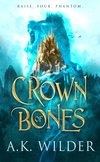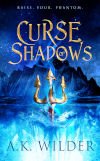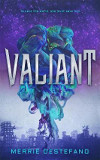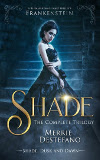.
One of the great things about the internet is that it facilitates communication with fellow authors, even those on the far side of the world. As a new author myself, I particularly enjoy getting to meet other new authors in the same field—and someone I have gotten to know, initially from via being on the Gemmell Morningstar Award shortlist together, then via Twitter and most recently through Abhinav Jain's "Names A New Perspective" guest author series is UK author Elspeth Cooper.
This week, Elspeth tagged me to do a "The Next Big Thing" post, which is all about authors tagging other writers and saying, "hey, tell us about yur work." Part of the fun of it is not just talking about what you are doing yourself, but shoulder tapping other writing friends to catch a glimpse of what they are working. And no question, catching that glimpse is always a joy.
So it was with real pleasure that I read Elspeth's "The Next Big Thing" post on The Raven's Shadow, the third book in her "The Songs of the Earth" series, right here. I hope you'll take a look and be as intrigued as I was.
Now, I have posted my take on The Next Big Thing on my own blog, but I enjoyed doing it and feel it's fun, so I thought I'd share it here with you today as well. May you enjoy!
1. What is the working title of your next book?
Ha! That’s easy: Daughter of Blood, The Wall of Night Book Three.
.
2. Where did the idea come from for the book?
Daughter of Blood is part of a series, so is part of the overall The Wall of Night quartet’s “big idea”, which is basically about an alternate world where an alien people, the Derai, believe themselves to be the champions of good, but are divided by prejudice suspicion and fear.
Where did that particular idea come from—I guess I’m of the school of Ursula Le Guin in the sense that I feel ideas are “just there”, in the ether so to speak, and as authors we simply reach out and pull them into being.
Having said that, the initial idea of a twilit shadowy world (the Wall of Night itself, in this case) first came when I was a kid living in Singapore where the equatorial nightfall always came very swiftly. Experiencing that left a real impression, and at the time I was also reading the Norse myths, with concepts such the twilight of the gods, and books like Alan Garner’s Elidor, about a world that is literally all in darkness. A little later, I was entranced by the Beleriand backstory alluded to in The Lord of the Rings, which is also full of shadow and darkness. So in a world building sense, I kept working with that idea in my head until the Wall of Night environment took more concrete shape.
In terms of the people who believe themselves to be the champions of good, but are divided by prejudice suspicion and fear—I think that idea probably comes out of my passion for history, as well as simply observing human fallibility via current affairs. But it was also sparked by long mulling over the trend I perceived in a great deal of the Fantasy I was reading, for the so-called “good guys” to do a lot of questionable stuff—but that was ok, by implication, simply because they were on the “right” side. I also really missed storytelling where the internal conflict within the protagonists is what really drives the story, not who smites whom and what colour hat they’re wearing when they do it (i.e. “white hats”/”black hats.”)
So I decided that I wanted to write a story where the internal conflict within both the individual protagonists, particularly Malian, the Heir of Night, and her friend Kalan (the two central characters), as well as their society (the Derai) is what the story is really all about.
.
3. What genre does your book fall under?
Again, with the “ha!” because I think I already answered this question under 2)–but I see The Wall of Night series as “epic” and/or “high” fantasy in the tradition of works such as Tolkien’s The Lord of the Rings and Guy Gavriel Kay’s Fionavar trilogy. It’s also been described as “Dark Fantasy” which I would agree with to the extent that there is a great deal of darkness in the story and some elements of horror—but it’s definitely not “Horror” in a genre sense.
.
4. What actors would you choose to play the part of your characters in a movie rendition?
This is such a hard question, because with Malian and Kalan I find it hard to pick out characters who really “fit” them, either in terms of how they look or their characters. I wonder of that’s partly because of how stereotyped female characters in particular are in film, in terms of portraying strength of character… Plus there’s the whole young Malian and Kalan in The Heir of Night, and grown up Malian and Kalan in The Gathering of the Lost and now Daughter of Blood. So I really am going to have to pass on this one because there really is no one I can readily point to who seems “right.”
.
5. What is the one-sentence synopsis of your book?
I’m going to go with Daughter of Blood on its own for this one, since I’ve already given you the one sentence for The Wall of Night series—so here goes…
“Fearing that their ancient enemy, the Darkswarm, is poised to rise, Malian and Kalan risk their freedom by returning to the Wall of Night—only to find that rather than uniting against external threat, the already dangerously weak Derai Alliance is focused on internal power plays and risks fracturing apart.”
.
6. Will your book be self-published or represented by an agency?
The Wall of Night series is published by HarperCollins in the USA, and Orbit in the UK, Australia and New Zealand. My work is represented by Robin Rue of Writers House Literary Agency.
.
7. How long did it take you to write the first draft of the manuscript?
I am still writing Daughter of Blood and have been working on it for just on a year now. It took me 5 years to complete The Heir of Night (145,000 words), writing very much as and when I could snatch the time. My second novel, Thornspell (70,000 words), took seven months, and The Gathering of the Lost (200,000 words) took just on two years to complete.
.
8. What other books would you compare this story to within your genre?
As above, I think the Wall series is epic Fantasy that sits in the same broad quadrant of the Fantasy universe as The Lord of the Rings and Guy Gavriel Kay’s Fionavar trilogy. Other stories I see as sitting in the same broad quadrant include:
- CJ Cherryh’s “Morgaine” chronicles
- Raymond E Feist & Janny Wurts’ “Empire” trilogy
- Robin Hobb’s “Assassin” and “Liveship” series
- Brandon Sanderson’s “The Way of Kings” series (although it’s only just begun, of course)
- Kate Elliott’s “Crown of Stars” series
- Tad Williams’ “Memory Sorrow and Thorn” series
- Patricia McKillip’s “Riddlemaster “ trilogy
- David Gemmell’s “Drenai” novels
.
9. Who or what inspired you to write this book?
Obviously I answered 2) far too comprehensively!
In addition to my answer there though, I will add that every really good book I’ve ever read inspired me in some way to write–and in that sense to write the WALL story, too.
.
10. What else about the book might pique the reader’s interest?
In addition to what I’ve already said about both The Wall of Night series and Daughter of Blood, readers may also enjoy the series if they like stories that are:
- Adventurous—this is a tale of quests and journeys, dungeon crawls and rooftop chases, battles, melees and contests of arms.
- Magical—the WALL series is also an intensely magical story, in fact Robin Hobb described HEIR as being imbued with “strange magic” and I think that’s a fair enough description…
- Twist-y and Turn-y—this is definitely not a story where, however classical the epic frame, you can ever rely on things always remaining as they initially seem…
- Friendship—and the conflicts of loyalty and honor that may arise from this, both within and external to the “band of brothers”, is one of the strongest themes that runs through the series.
- (And yes) Love—which began to enter the series in The Gathering of the Lost and evolves further in Daughter of Blood. (I’m not saying any more though, because that would be a—boo, hiss—Spoiler!)
- Character-driven—this is a story that is very much driven by the characters. The touchstone question for me is always: “will the character, given how she/he has evolved, do this?” If the answer is no (and it was several times in The Gathering of the Lost) then it’s the story that has to change rather than having the characters do something ‘out of character’ just to make the plot work.
—
Now I am delighted to say that the following excellent authors, listed in alphabetical order by surname, have all agreed to do a “The Next Big Thing” post next week on Wednesday 5 December. Just click on the author’s name to go to their site:
- Julie Czerneda – author of SF such as the Trade Pact series, and the forthcoming Fantasy novel, Turn of Light
- Kate Elliott – author of Fantasy series such as the Crown of Stars sequence and Spirit Walker trilogy
- Kim Falconer – one of our own Supernatural Undergrounders and author of the Quantum Enchantment & Quantum Encryption Fantasy-SciFi series
- Stina Leicht – author of the Fey And The Fallen series
- Mary Victoria – author of The Chronicles of the Tree trilogy
And by the way – a merry festive season everyone. I hope it finds you all safe, well, and together with the people you love.





Small.jpg)


















1 comment:
oh! thanks for some info on book 3. I am looking forward to finding out what is happening on The Wall !
Post a Comment